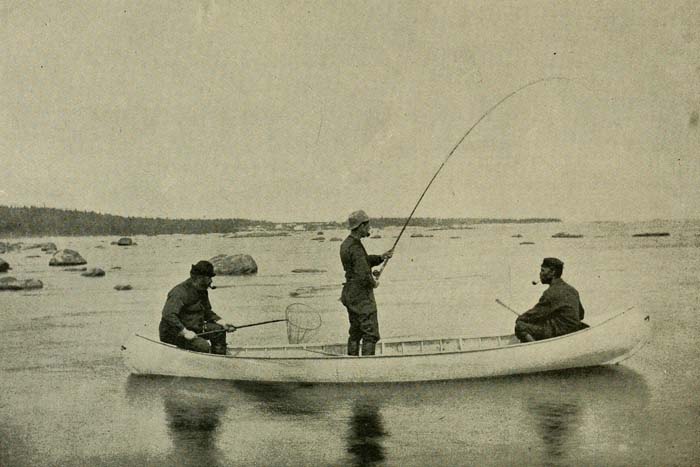
A fly rod review? Photo and copy by Edward A. Samuels in 1890 for Forest and Stream, New York, NY. The first outdoor magazine. Partial caption: Leaving Lake Edward you resume your journey to Lake St. John. When I visited the lake the train connected with the pioneer steamer, the Peribonca, and on this boat I had a two or three hours sail to the Hotel Roberval, one of the most comfortable and best kept hotels in Canada. NOTE: Roberval is a city on the south-western shore of Lac Saint-Jean in Quebec, Canada. A commons image.
[dropcap]M[/dropcap]any products are a pleasure to review and sometimes you get to keep the product your reviewing. Sometimes companies do that. I guess they figure it’s “used” and they don’t sell used or they asked for a favor, and that’s a payback. Many times I don’t want the product because I didn’t like it, so it’s only fair to send it back without comment. Too, it could become a birthday gift to a relative you hardly know – if you did review it.
If the product has functional specifications, you can capture what readers can expect in performance by quickly putting everything together to say it can’t do this or that but can do these things – and so on. Fly lines and leader materials are like that.
Book reviews are mostly fun because “your” opine is expected to be yours only – not necessarily lining up with another reviewer thoughts. And sometimes you discover a gem of a writer like Steve Kantner.
Angie Roth, a retired trial attorney, my fly fishing friend and sometimes irascible person, is an excellent fly fisher who has to have whatever is the newest toy in the fly shop. A while ago she called to flaunt her latest beloved, the IGNITER from Sage. She had a 6-weight version that we exercised on the Eberle Farmstead on the NC/GA border under difficult winter water conditions. This rod is “effing” good.

Image Madison River Fishing Company – see their IGNITER rod review below.
The Sage IGNITERS start at said freshwater entrants, 4-weight up to a 6-weight. Then they ID the 6- to 10-weight as saltwater (full wells grip and metal reel seat). This line-up is a pretty big roll-out commitment for new rods from a major like Sage. Usually, big companies hang back with their newest-best ever fly rods with just a few releases like a 5-weight along with an 8- or 9-weight – showing they can run on any track, trout or saltwater and always add the comment “more models coming soon” or something like that.
If a new best ever fly rod has fly sales shop traction the manufacturer will fill out the freshwater rod line with 4- to 6-weight and saltwater line 7- thru 10-weight – just like Sage has. On the third release the coup de grâce, 1-, 2- and 3- weights and 11 and 12-weights and higher to 14-weight if it’s got billfish guts (the rod not the company).
Here’s the thing
All fly rods and all fly reels are low on specifications that relate to performance, relying instead of periphery specs: weight, length, guides, diameter, reel seat type, grip type, and features like fast action, sealed drag, smooth, and blah, blah, blah. Those notations at best just “features,” not performance specs – the rest is usually just good PR wordsmithing. Blah, blah is as specifications noteworthy as smooth or med-fast.
Reviewing a fly rod requires a strong knowledge of fly rods, experience fly fishing in the salt or freshwater or both, and a lot of skill at writing so that you make any “modifier” sound like it has technological significance. It’s sadly the only way a reviewer can let the secret out of the box that should just allow him or her to say:
This fly rod is really “effing” good
For another IGNITER review . . .
For a more standard review of Sage’s IGNITER go here . . .
[information]
[/information]






Join the discussion One Comment